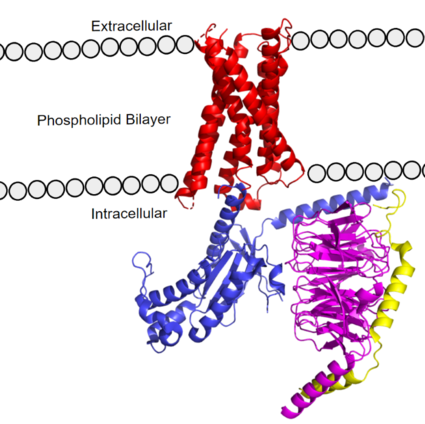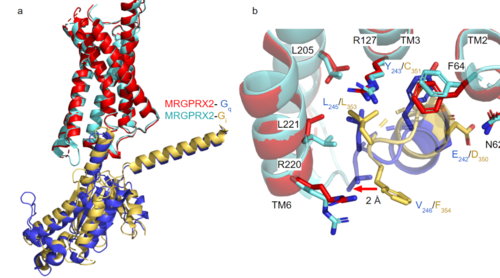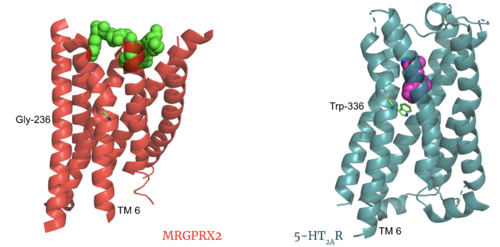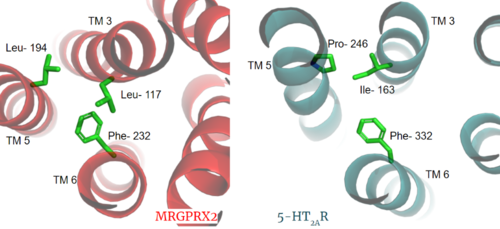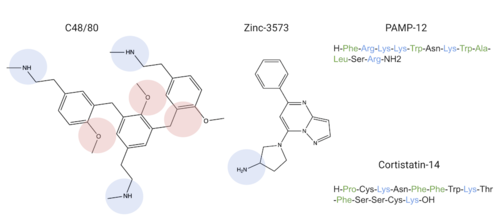Sandbox Reserved 1700
From Proteopedia
(Difference between revisions)
| Line 8: | Line 8: | ||
== Background == | == Background == | ||
GCPR’s or G-Protein Coupled Receptors are a large family of protein receptors that promote cellular signaling and signal transduction <ref name= “Tuteja”>PMID: 19826234</ref>. GPCRs transmit extracellular signals to intracellular messages. Many essential pathways utilize GPCRs, including human vision by the GPCR [https://proteopedia.org/wiki/index.php/Rhodopsin Rhodopsin], and the [https://proteopedia.org/wiki/index.php/Beta2_adrenergic_receptor-Gs_protein_complex_updated adrenaline fight-or-flight response] by the β2-adrenoceptor GPCR. Understanding GPCR’s and how they produce their desired intracellular signal is essential to studying essential cellular pathways, especially in their diseased states. GCPRs are common drug targets, with 475 drugs acting on over 100 GPCRs. An additional 300 drugs are in clinical trial stages, and 20% of those drugs are targeting novel GPCRs <ref name="Hauser">PMID:29075003</ref>. Because of the clinical relevance of GPCRs, new structures provide new avenues for drug development to both treat disease or modulate the harmful side effects. | GCPR’s or G-Protein Coupled Receptors are a large family of protein receptors that promote cellular signaling and signal transduction <ref name= “Tuteja”>PMID: 19826234</ref>. GPCRs transmit extracellular signals to intracellular messages. Many essential pathways utilize GPCRs, including human vision by the GPCR [https://proteopedia.org/wiki/index.php/Rhodopsin Rhodopsin], and the [https://proteopedia.org/wiki/index.php/Beta2_adrenergic_receptor-Gs_protein_complex_updated adrenaline fight-or-flight response] by the β2-adrenoceptor GPCR. Understanding GPCR’s and how they produce their desired intracellular signal is essential to studying essential cellular pathways, especially in their diseased states. GCPRs are common drug targets, with 475 drugs acting on over 100 GPCRs. An additional 300 drugs are in clinical trial stages, and 20% of those drugs are targeting novel GPCRs <ref name="Hauser">PMID:29075003</ref>. Because of the clinical relevance of GPCRs, new structures provide new avenues for drug development to both treat disease or modulate the harmful side effects. | ||
| + | |||
Some cells in the human body that express the MRGPRX2 receptor include mast cells in the skin, intestines, and trachea <ref name="Porebski">PMID:30619367</ref><ref name="Dondalska">PMID: 33101278</ref>. Mast cells are immune cells responsible for triggering inflammatory responses and are densely packed with granules containing inflammatory chemicals <ref name= "Dondalska" />. Mast cells can be activated by either antibodies from the immune response or upon ligands binding to MRGPRX2 receptors on their surface<ref name="McNeil">PMID: 25517090</ref>. Upon activation, mast cells will release granules containing histamine and other inflammatory chemicals in the body, which can trigger a larger inflammatory response <ref name= "Dondalska" /><ref name="McNeil" />. These responses induce common allergic reaction and anaphylaxis symptoms, such as cutaneous itching sensations or airway constriction | Some cells in the human body that express the MRGPRX2 receptor include mast cells in the skin, intestines, and trachea <ref name="Porebski">PMID:30619367</ref><ref name="Dondalska">PMID: 33101278</ref>. Mast cells are immune cells responsible for triggering inflammatory responses and are densely packed with granules containing inflammatory chemicals <ref name= "Dondalska" />. Mast cells can be activated by either antibodies from the immune response or upon ligands binding to MRGPRX2 receptors on their surface<ref name="McNeil">PMID: 25517090</ref>. Upon activation, mast cells will release granules containing histamine and other inflammatory chemicals in the body, which can trigger a larger inflammatory response <ref name= "Dondalska" /><ref name="McNeil" />. These responses induce common allergic reaction and anaphylaxis symptoms, such as cutaneous itching sensations or airway constriction | ||
<ref name= "Cao" /><ref name= "Yang" /><ref name="McNeil">PMID: 25517090</ref>. | <ref name= "Cao" /><ref name= "Yang" /><ref name="McNeil">PMID: 25517090</ref>. | ||
| Line 128: | Line 129: | ||
=== Clinical Relevance === | === Clinical Relevance === | ||
| - | + | Many medications commonly list chronic skin itching or inflammatory responses as side effects, such as nateglinide, an anti-diabetic drug <ref name= "Cao" />. Other drugs that have been known to trigger allergic reactions and even anaphylactic responses are opioids morphine or codeine<ref name= "Cao" />, which could explain anaphylactic responses to anesthetics seen in some patients<ref name="McNeil" />. Upon analysis of these drugs, they share many structural similarities that are known to bind to the sub-pockets in MRGPRX2, shown in TABLE **, which is a possible explanation for the unwanted itch and inflammation responses produced in some patients when administering these drugs <ref name="McNeil" /><ref name= "Cao" />. | |
| - | <ref name= " | + | |
| + | Possible treatments for these unwanted side effects of drugs can be developed by understanding the mechanism of the MRGPRX2 receptor. Research on Cortistatin-14, an endogenous neuropeptide, has shown that it has antiinflammatory properties because of how it binds to the MRGPRX2 receptor <ref name= "Gonzalez-Rey">PMID: 16492802</ref>. Additionally, Osthole, an extract from Cnidium monnieri plants, also known as Monnier's snowparsley, demonstrates similar MRGPRX2 inhibition because of its structural similarity to many known ligands for this receptor, and could possibly be used as a treatment option for adverse allergic reactions to commonly prescribed drugs (donstralta). More research on MRGPRX2 can open the door for the development of drugs that avoid activation of the MRGPRX2 receptor, or possible treatments for excessive inflammation and allergic reactions. | ||
| + | |||
| - | Many medications commonly list chronic skin itching or inflammatory responses as side effects, such as nateglinide, an anti-diabetic drug <ref name= "Cao" />. Upon analysis of some medications that list itching as side effects such as nateglinide, they structurally share many similarities to known MRGPRX2 ligands, and could therefore initiate an unwanted itch response in patients. Other drugs such as morphine or codeine also share structural features to known MRGPRX2 ligands, which can contribute to itching side effects seen in users of these drugs <ref name= "Cao" />. | ||
Because of how some drugs initiate an unwanted itch response, | Because of how some drugs initiate an unwanted itch response, | ||
Revision as of 14:49, 12 April 2022
MRGPRX2 Human Itch G-Protein Coupled Receptor (GPCR)
| |||||||||||
References
- ↑ Tuteja N. Signaling through G protein coupled receptors. Plant Signal Behav. 2009 Oct;4(10):942-7. doi: 10.4161/psb.4.10.9530. Epub 2009, Oct 14. PMID:19826234 doi:http://dx.doi.org/10.4161/psb.4.10.9530
- ↑ Hauser AS, Attwood MM, Rask-Andersen M, Schioth HB, Gloriam DE. Trends in GPCR drug discovery: new agents, targets and indications. Nat Rev Drug Discov. 2017 Dec;16(12):829-842. doi: 10.1038/nrd.2017.178. Epub, 2017 Oct 27. PMID:29075003 doi:http://dx.doi.org/10.1038/nrd.2017.178
- ↑ 3.0 3.1 Porebski G, Kwiecien K, Pawica M, Kwitniewski M. Mas-Related G Protein-Coupled Receptor-X2 (MRGPRX2) in Drug Hypersensitivity Reactions. Front Immunol. 2018 Dec 20;9:3027. doi: 10.3389/fimmu.2018.03027. eCollection, 2018. PMID:30619367 doi:http://dx.doi.org/10.3389/fimmu.2018.03027
- ↑ 4.0 4.1 4.2 4.3 Dondalska A, Ronnberg E, Ma H, Palsson SA, Magnusdottir E, Gao T, Adam L, Lerner EA, Nilsson G, Lagerstrom M, Spetz AL. Amelioration of Compound 48/80-Mediated Itch and LL-37-Induced Inflammation by a Single-Stranded Oligonucleotide. Front Immunol. 2020 Sep 30;11:559589. doi: 10.3389/fimmu.2020.559589. eCollection, 2020. PMID:33101278 doi:http://dx.doi.org/10.3389/fimmu.2020.559589
- ↑ 5.0 5.1 5.2 5.3 5.4 5.5 5.6 McNeil BD, Pundir P, Meeker S, Han L, Undem BJ, Kulka M, Dong X. Identification of a mast-cell-specific receptor crucial for pseudo-allergic drug reactions. Nature. 2015 Mar 12;519(7542):237-41. doi: 10.1038/nature14022. Epub 2014 Dec 17. PMID:25517090 doi:http://dx.doi.org/10.1038/nature14022
- ↑ 6.0 6.1 6.2 6.3 6.4 6.5 6.6 6.7 6.8 6.9 Cao C, Kang HJ, Singh I, Chen H, Zhang C, Ye W, Hayes BW, Liu J, Gumpper RH, Bender BJ, Slocum ST, Krumm BE, Lansu K, McCorvy JD, Kroeze WK, English JG, DiBerto JF, Olsen RHJ, Huang XP, Zhang S, Liu Y, Kim K, Karpiak J, Jan LY, Abraham SN, Jin J, Shoichet BK, Fay JF, Roth BL. Structure, function and pharmacology of human itch GPCRs. Nature. 2021 Dec;600(7887):170-175. doi: 10.1038/s41586-021-04126-6. Epub 2021, Nov 17. PMID:34789874 doi:http://dx.doi.org/10.1038/s41586-021-04126-6
- ↑ 7.0 7.1 7.2 7.3 7.4 7.5 7.6 7.7 Yang F, Guo L, Li Y, Wang G, Wang J, Zhang C, Fang GX, Chen X, Liu L, Yan X, Liu Q, Qu C, Xu Y, Xiao P, Zhu Z, Li Z, Zhou J, Yu X, Gao N, Sun JP. Structure, function and pharmacology of human itch receptor complexes. Nature. 2021 Dec;600(7887):164-169. doi: 10.1038/s41586-021-04077-y. Epub 2021, Nov 17. PMID:34789875 doi:http://dx.doi.org/10.1038/s41586-021-04077-y
- ↑ Kamato D, Thach L, Bernard R, Chan V, Zheng W, Kaur H, Brimble M, Osman N, Little PJ. Structure, Function, Pharmacology, and Therapeutic Potential of the G Protein, Galpha/q,11. Front Cardiovasc Med. 2015 Mar 24;2:14. doi: 10.3389/fcvm.2015.00014. eCollection, 2015. PMID:26664886 doi:http://dx.doi.org/10.3389/fcvm.2015.00014
- ↑ Trzaskowski B, Latek D, Yuan S, Ghoshdastider U, Debinski A, Filipek S. Action of molecular switches in GPCRs--theoretical and experimental studies. Curr Med Chem. 2012;19(8):1090-109. doi: 10.2174/092986712799320556. PMID:22300046 doi:http://dx.doi.org/10.2174/092986712799320556
- ↑ Olivella M, Caltabiano G, Cordomi A. The role of Cysteine 6.47 in class A GPCRs. BMC Struct Biol. 2013 Mar 15;13:3. doi: 10.1186/1472-6807-13-3. PMID:23497259 doi:http://dx.doi.org/10.1186/1472-6807-13-3
- ↑ Gonzalez-Rey E, Chorny A, Robledo G, Delgado M. Cortistatin, a new antiinflammatory peptide with therapeutic effect on lethal endotoxemia. J Exp Med. 2006 Mar 20;203(3):563-71. doi: 10.1084/jem.20052017. Epub 2006 Feb, 21. PMID:16492802 doi:http://dx.doi.org/10.1084/jem.20052017
